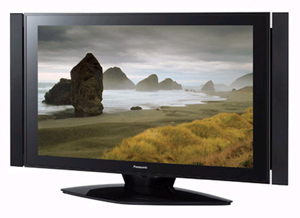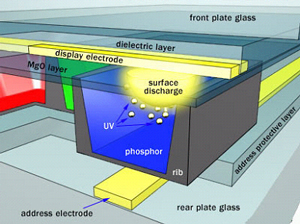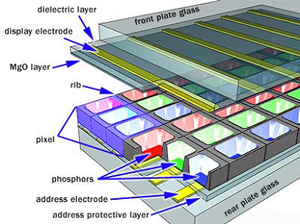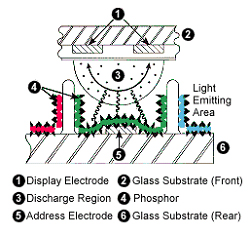Plasma Format
Plasma Display Devices are capable of displaying full HDTV and DTV (digital television) signals as well as XGA, SVGA and VGA computer signals. Plasma can display excellent detail with its 1024 x 1024 pixel high-resolution rated for 43-inch diagonal models. Its range of diagonal screen sizes go from around 30-inch to 60-inch diagonal. (see pixel resolution chart further below for all screen sizes.) And unlike some LCD's, Plasma sets can display images at true 1080i and 720p HDTV without the need for scaling, including 480i and 480p HD signals (see glossary.) Plasma displays should include built-in line doubling to further improve image quality when viewing standard analog NTSC video sources such as TV broadcasts, RF signals from cable boxes, and VCR outputs. This eliminates your having to see the annoying scan lines of the enlarged standard NTSC picture that was designed for the world of 4:5 aspect ratio. High-end Plasma displays are also capable of displaying 16.7 million colors, similar to the LCD/TV's, Plasma providing superb color realism with exceptionally subtle gradations of dark and light between colors, and why a plasma picture may be considered more pure than one seen on an LCD/TV screen. Plasma display devices, like LCD/TV's, have a wide-screen 16:9 aspect ratio, a ratio that explains the relationship between the screen's width vs. height; width (16) and height (9.) This is called an aspect ratio and is used for HDTV pictures that allow DVD-Video movies to be viewed in the wide-screen mode, similar to what is seen in the movie theater, although the 70mm films you see in movie theaters will be even wider. And like LCD/TV's, Plasma display monitors have screens that are perfectly flat. The Plasma format also virtually removes all edge distortion that can occur in a CRT or projection display that has not been properly converged. And unlike some older rear- and front-projection televisions that suffered from uneven screen brightness with the center looking hot (meaning brighter than the rest of the screen), the Plasma format displays brightness and detail faithfully across the viewing area, illuminating all pixels evenly on its flat screen surface. But best of all, Plasma display devices are only a few inches thick, providing wall-hanging installation options, not possible with the less expensive rear-projection and Direct-View formats, that will need ceiling mounts and wall mounts for businesses applications. . . or for consumers, even bedroom ceiling mounts for late night viewing for those who can afford it. To this end, Plasma users can be assured they will enjoy big-screen home theater that totally eliminates making a footprint on the floor of the room that is zero space. For instance, you can hang a Plasma unit on a wall while putting a piece of furniture below it, as you would do with any large hanging mirror. (A seed idea from me to the plasma manufacturer for another application, eh?) As seen below, plasma monitors include a sleek "picture frame" look that blends in with almost any decor except probably Colonial. The chassis holds all the electronics and is not much wider than the display screen itself, the entire unit being only about 6-inches thick, or 1/2 foot. And displays are offered with an excellent side-viewing angles nearing 160 degrees, side-to-side and top-to-bottom. But like we discovered in the chapter on Audio, Total Music Power ratings are not RMS. So when checking out which format to buy and you're concerned with the maximum viewing angle, simply stand to the side of the set and see for yourself when an image is on the screen. Spec sheet writers are fed by product managers, who can be overly enthusiastic about their products. So use your eyes. They will not lie. Keep in mind, however, that these wide-viewing angles are just amazing, noting that 180-degrees is the perfect viewing angle that can never be achieved, because at that angle you're literally looking at the side of the set and no longer at the screen. Many HDTV Plasma monitors can also accept other video formats. Typically, these others will include the American composite video NTSC system along with the PAL and SECAM formats popular for overseas viewing (see a previous chapter for worldwide format Web site link.) The Plasma set uses excellent signal pass-through with brass or gold covered RCA jacks, high-resolution S-Video inputs, component video inputs, plus serial-port type of jacks that accept RGB inputs from a computer source to display on your plasma screen. This allows the plasma technology to provide its user with connections to practically all video output sources. Also, like LCD/TV's, Plasma displays do not use electron beams and are therefore not affected by large magnetic fields, such as by an audio speaker that has been placed to close to the viewing device. The magnetic field from a base speaker's large magnet can cause a CRT's screen to display a wrong color or a rainbow of colors at its edge closest to the speaker. That will not happen with a Plasma HDTV set. The Plasma technology works by illuminating tiny, colored fluorescent lights to form an image on its flat surface. Each pixel is made up of three fluorescence; red, green, and blue. (Refer to an earlier chapter discussing the primary colors for transmitted light vs. reflective light.) Just like a CRT television, the Plasma display varies the intensities of the three different phosphorous colors to produce a full range of colors similar to the CRT's arrangement of pixels. These Plasma pixels are made up of color cells called sub-pixels. If you are interested in how the plasma technology generates color, continue reading. If not, scroll down to move past the how it works section. ____________________________________ How It Works
The central element in a fluorescent is a "plasma gas" made up of free-flowing ions (electrically charged atoms) and electrons (negatively charged particles.) Under normal conditions a gas is mainly made up of uncharged particles, the individual gas atoms including equal numbers of protons (positively charged particles in the atom's nucleus) and electrons. The negatively charged electrons perfectly balance the positively charged protons, so the atom has a net charge of "zero."
If many free electrons are introduced into the plasma gas, they establish an electrical voltage that can be changed instantly. These free electrons collide with the atoms, knocking loose other electrons. If you took physics, you learned with a missing electron, an atom loses its balance creating a net positive charge called an ion. With an electrical current running through the plasma gas, negatively charged particles are pulled toward the positively charged area of the plasma, and positively charged particles are pulled toward the negatively charged area causing a collision of particles. These collisions excite the gas atoms in the plasma, causing them to release photons of energy, creating and releasing light, these gases being made up of xenon and neon atoms. You know what a neon light looks like, eh? These atoms also release ultraviolet light photons that are invisible to the human eye. But in the plasma technology they are used to excite visible light photons the xenon and neon plasma gas contained in hundreds of thousands of tiny cells positioned between two plates of glass, similar to LCD technology where gels were used instead to transmit the light.
Long electrodes are also sandwiched between these glass plates behind the cells and along the rear glass plate. These transparent electrodes, which are surrounded by an insulating dielectric material and covered by a magnesium oxide protective layer, are then mounted above the cell and along the front of the glass plate. The rear electrodes behind the cells are called "Address Electrodes" while the ones placed in front of the cells are called "Display Electrodes (see graphics.)" Both sets of electrodes extend across the entire screen's surface. The front "Display" electrodes are arranged in horizontal rows while the rear "Address" electrodes are arranged in vertical columns, forming a grid. The "Display" and "Address" electrodes are arranged so they alternate between each other above and below the cell. A built-in computer circuit charges each of these cell thousands of times within a fraction of a second where the "Address" and "Display" electrodes intersect each other, applying different voltages between them that causes a selected voltage difference to flow through the cell between them, which ionizes the gas causing it to release ultraviolet photons.
The released ultraviolet photons interact with phosphor material coated on the inside wall of the cell, phosphors a substance that gives off light when exposed to the ultraviolet light. When an ultraviolet photon hits a phosphor atom in the cell, one of the phosphor's electrons jumps to a higher energy level and the atom heats up, releasing a visible light photon when that electron falls back to its previous normal level. The phosphors in a plasma display give off colored light when they are excited. Each pixel is made up of three separate sub-pixel cells, each with different colored phosphors. One sub-pixel has a red light phosphor, another green, and another blue. These colors blend together to the eye to create the overall color of the pixel. By varying the changing current flowing through the different cells, the control system can instantly increase or decrease the intensity of each sub-pixel color to create hundreds of different combinations of red, green and blue. In this way, the plasma control system can produce colors across the entire color spectrum. ____________________________________
The bottom-line advantage of Plasma display technology over other formats is that it can produce a very wide screen using extremely thin materials without the need for a backlight to create brightness. And because each pixel is lit individually by sub-pixels, the image is very bright and looks good from virtually every angle. The image quality is almost the same as the best CRT displays, and therefore will meet the viewer's image expectation.
The biggest drawback of this technology, however, is price. With prices starting at $3,200 for a 42-inch diagonal set to a 50-inch diagonal set for around eight bills, these sets are truly designed for the videophiles who can afford them. But as the technology advances and prices drop, and TV's of the future are surely going to evolve to only wall-hanging formats. Be aware that some merchants may keep the price artificially down of a new Plasma television flat-panel HDTV sets by not including a needed built-in tuner or stereo audio system (ouch!) If you are buying into this basic Plasma configuration, you are in essence purchasing a pure video monitor, similar to the application of the one attached to your computer. To see anything on the screen, as with a computer monitor you will have to connect it to a video source such as an add-on tuner or digital HDTV cable box. You can visit the following site to see the different cable-tuner boxes that are available for your new Plasma flat-screen TV. If hanging your Plasma TV on the wall, remember that if you don't want any wiring to show you will need to create a hole in the wall behind your new TV and then below the set on the floor, enabling you to run cables up to your new HDTV Plasma set. Therefore, be sure when buying cables you purchase them in correct lengths so they are not stretched. Also, for instance, normal everyday DVI cables should not go beyond 15 feet in length, so your cable box should be easily within 15 feet of the back of the jack-pack at the rear of your Plasma wide-screen HDTV monitor as it hangs on the wall. Home Theater installations may use longer lengths but the cables are extremely well-built and very expensive. While you can get HDTV programming from an external antenna if your local television station is transmitting the signal, you can also subscribe to your local cable-provider using their digital decoder box, being sure they have HDTV service available along with a S-Video, Component and / or DVI Output on the back of their box including left / right stereo output audio jacks. The sophisticated external RF-input tuners you buy from other manufacturers will not descramble a local cable-provider's scrambled channels when having purchased your cable company's premium movie package. You could save some money if you find a box that will do this, later enjoying its presence with you in jail. So don't ever go there. Reparable cable-box providers will not sell them to you. If you come across a provider, e-mail, or direct mail that will, run! And again, as I say with all HDTV projection sets that are not CRT's, check out what audio, if any, comes with the set and if you will need to buy a supplemental audio system to create the reality in sound you are looking for to go with the larger HDTV picture. This could add $800 or more to the price of your purchase. In addition, check out the all-important jack-pack to see what kind and how many inputs and outputs you have available to you when you get home to hook up your toy. In a later chapter, as already mentioned, you will see a picture of my Sony set's jack-pack that is just simply amazing in flexibility. Burn-in:
___________________________________ ___________________________________
LCD vs. Plasma: Which Is Right for You?
Go to Chapter 12, "DLP Format"
Copyright freedomisknowledge.com 2007-2008 |
|
Index
|



